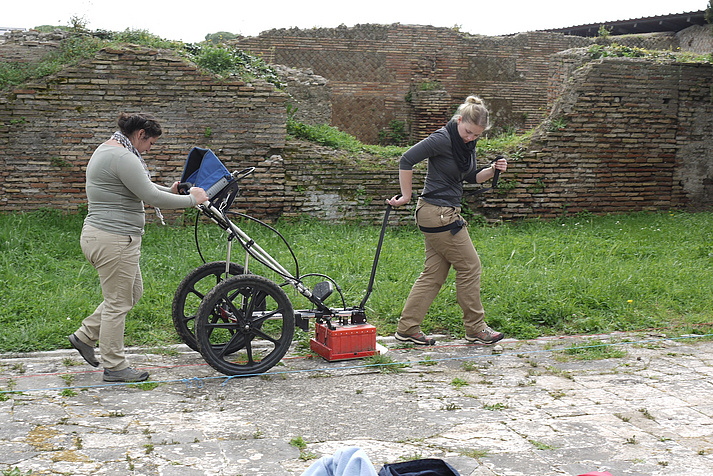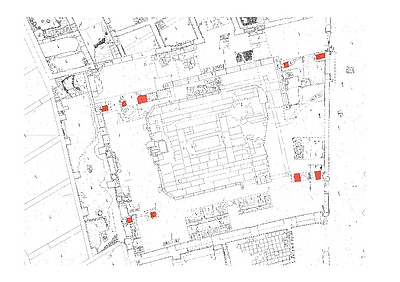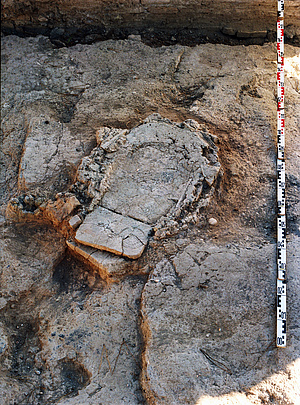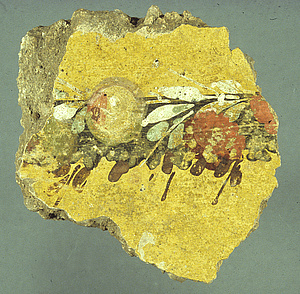Ostia – Macellum
During the late 1930s, large parts of Ostia (antica), Rome’s seaport at the mouth of the Tiber, were exposed and restored within a short time. Among the finds were a building complex near the historic city centre, that was soon named the Macellum (indoor market for mainly fruit and vegetable) of the ancient big city.
Doubts about the name and the function of this complex led to a number of excavation campaigns that could largely clarify its development history. Traces of first use, possibly a sanctuary, go back to the early days of Ostia during the 3rd century BC. At the latest around 50 BC, the site was overbuilt with complex building structures of stores and housing, followed by two independent complexes, a multi-storey apartment building and a representative courtyard building, in the second half of the first century BC. Including numerous renewals and changes the building complex lasted into the city’s later years (4th and 5th century AD) and was then deserted like the entire city.
No Macellum
The excavations proved that the name Macellum cannot be applied. Courtyard and residential building (so-called insula) existed independently and they do not correspond with the typical features of a public market. The lot is proof for Ostia’s characteristic dynamics regarding its construction activities and their constant adapting to new needs. During Late Antiquity even several spaces were used for glass furnaces. For the first time such production could be accounted for in Ostia. The important results of the investigation also include a continuous stratigraphy across the complete time period the lot was used.
After the excavation during the 1930s, ancient relics were intensively reshaped according to the excavators’ perception, far beyond the usual conservation and preservation activities, so they would produce a consistent picture of the city’s heyday (during the 2nd century AD). To this day, this in some ways ahistorical view on the landscape of ruins has been forming the picture of large parts of Ostia and it does impede the view on a centuries-long development of a complex urban structure.

Literature
Kockel, Valentin – Ortisi, Salvatore, Ausgrabungen der Universität Augsburg im sog. Macellum von Ostia, Mededelingen van het Nederlands Instituut te Rome = Papers of the Dutch Institute in Rome 58 (1999), 22-26.
Kockel, Valentin – Ortisi, Salvatore, Ostia, sog. Macellum (VI 5,2). Vorbericht über die Ausgrabungen der Universität Augsburg 1997/98, Mitteilungen des Deutschen Archäologischen Instituts, Römische Abteilung 107 (2000), 351-363.
Rottloff, Andrea, Gläser und Reste von Glasverarbeitung aus Ostia, Mitteilungen des Deutschen Archäologischen Instituts, Römische Abteilung 107 (2000), 365-374.
Kockel, Valentin, Fragmente von Wandmalerei aus dem sogenannten Macellum in Ostia (IV 5,2) (mit einem Appendix zur Datierung von Salvatore Ortisi), in: Irene Bragantini (Hrsg.), Atti del X Congresso internazionale dell'AIPMA, Napoli 17-21 settembre 2001 (Napoli 2010), 481-487.
Kockel, Valentin, Fragmente marmorner Architekturverkleidungen aus dem sog. Macellum in Ostia (IV, V, 2), Mitteilungen des Deutschen Archäologischen Instituts, Römische Abteilung 120, 2014, 227-242.
Kockel, Valentin – Ortisi, Salvatore, Increases in levels and changes in use of the so-called Macellum in Ostia, in: F. van Haeperen – C. De Ruyt (Hrsg.), Ostia Antica. Nuovi studi e confronto delle ricerche nei quartieri occidentali (Brüssel-Rom 2017), 207-215.
Further Information
The Project
Project Lead
Prof Dr. Valentin Kockel
Klassische Archäologie
Universität Augsburg
86135 Augsburg
E-Mail
Together with Prof. Dr. Salvatore Ortisi (München)
Funding
This project is funded by the Bavarian Academy of Science and Humanities and the University of Augsburg.



